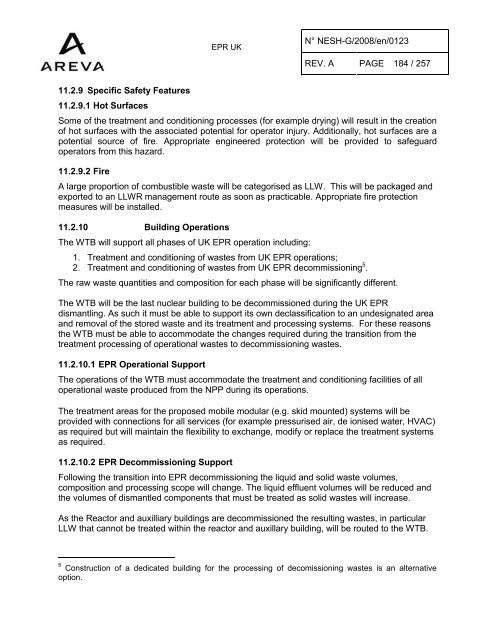Solid Radioactive Waste Strategy Report.pdf - UK EPR
Solid Radioactive Waste Strategy Report.pdf - UK EPR
Solid Radioactive Waste Strategy Report.pdf - UK EPR
Create successful ePaper yourself
Turn your PDF publications into a flip-book with our unique Google optimized e-Paper software.
<strong>EPR</strong> <strong>UK</strong><br />
N° NESH-G/2008/en/0123<br />
REV. A PAGE 184 / 257<br />
11.2.9 Specific Safety Features<br />
11.2.9.1 Hot Surfaces<br />
Some of the treatment and conditioning processes (for example drying) will result in the creation<br />
of hot surfaces with the associated potential for operator injury. Additionally, hot surfaces are a<br />
potential source of fire. Appropriate engineered protection will be provided to safeguard<br />
operators from this hazard.<br />
11.2.9.2 Fire<br />
A large proportion of combustible waste will be categorised as LLW. This will be packaged and<br />
exported to an LLWR management route as soon as practicable. Appropriate fire protection<br />
measures will be installed.<br />
11.2.10 Building Operations<br />
The WTB will support all phases of <strong>UK</strong> <strong>EPR</strong> operation including:<br />
1. Treatment and conditioning of wastes from <strong>UK</strong> <strong>EPR</strong> operations;<br />
2. Treatment and conditioning of wastes from <strong>UK</strong> <strong>EPR</strong> decommissioning 5 .<br />
The raw waste quantities and composition for each phase will be significantly different.<br />
The WTB will be the last nuclear building to be decommissioned during the <strong>UK</strong> <strong>EPR</strong><br />
dismantling. As such it must be able to support its own declassification to an undesignated area<br />
and removal of the stored waste and its treatment and processing systems. For these reasons<br />
the WTB must be able to accommodate the changes required during the transition from the<br />
treatment processing of operational wastes to decommissioning wastes.<br />
11.2.10.1 <strong>EPR</strong> Operational Support<br />
The operations of the WTB must accommodate the treatment and conditioning facilities of all<br />
operational waste produced from the NPP during its operations.<br />
The treatment areas for the proposed mobile modular (e.g. skid mounted) systems will be<br />
provided with connections for all services (for example pressurised air, de ionised water, HVAC)<br />
as required but will maintain the flexibility to exchange, modify or replace the treatment systems<br />
as required.<br />
11.2.10.2 <strong>EPR</strong> Decommissioning Support<br />
Following the transition into <strong>EPR</strong> decommissioning the liquid and solid waste volumes,<br />
composition and processing scope will change. The liquid effluent volumes will be reduced and<br />
the volumes of dismantled components that must be treated as solid wastes will increase.<br />
As the Reactor and auxilliary buildings are decommissioned the resulting wastes, in particular<br />
LLW that cannot be treated within the reactor and auxillary building, will be routed to the WTB.<br />
5 Construction of a dedicated building for the processing of decomissioning wastes is an alternative<br />
option.

















